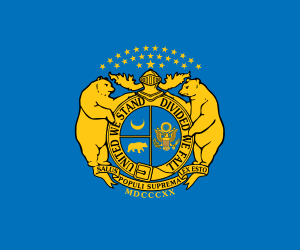Battle of Little Blue River
The Battle of Little Blue River was a minor battle of the American Civil War, occurring on October 21, 1864 in Jackson County, Missouri during Price's Missouri Expedition of that year. It became the opening round of the Second Battle of Independence, which began on this same day and was essentially a continuation of this engagement. This led in turn to the Battle of Westport on October 23, resulting in Price's defeat and the ending of major Confederate military operations in Missouri.
Background
In the fall of 1864, Confederate Maj. Gen. Sterling Price was dispatched by his superior, Lt. Gen. Edmund Kirby Smith, to attempt to seize Missouri for the Confederacy. Unable to attack his primary objective, St. Louis, Price decided to execute Smith's backup plan for a westward raid through Missouri and into Kansas and the Indian Territory. Their ultimate goal was to destroy or capture Union supplies and outposts, which might negatively affect Abraham Lincoln's chances for reelection in 1864.
After his victory at the Battle of Glasgow, Missouri, Price continued his march westward, in the direction of Kansas City and Fort Leavenworth, headquarters of the Federal Department of Kansas. But his progress was slow, giving the Union Army a chance to concentrate their forces. Maj. Gen. William S. Rosecrans, commanding the Department of the Missouri, proposed a pincer movement to trap Price and his army, but he was unable to communicate with Maj. Gen. Samuel R. Curtis, commander of the Department of Kansas, to formalize the plan. Curtis was experiencing difficulty because many of his soldiers were Kansas militia (under George Dietzler), and they refused to enter Missouri. However, a force of about 2,000 men under the command of Maj. Gen. James G. Blunt did set out for Lexington. He met the Confederate troops there on October 19 and slowed their progress, but was ultimately forced to withdraw. On the 20th, Blunt’s retreating column arrived on the Little Blue River, a minor stream five miles east of Independence.
Battle

The Union force turned at the Little Blue to engage the Confederates again, using strong defensive positions on the west bank. Curtis, however, ordered Blunt back to Independence, leaving only a token force, under Col. Thomas Moonlight, on the river itself. The following day, however, Curtis ordered Blunt to take all of his volunteers and return to the Little Blue.
As Blunt neared the stream, he discovered that Moonlight’s small force had engaged Price's advance guard just after sunup, burning the bridge as previously ordered. Price's main force had arrived by this time and was fiercely engaging Moonlight's brigade, which was stubbornly guarding every available ford in the area. Blunt quickly entered the fray, attempting to drive Price back beyond the defensive positions that he wished to reoccupy. A five-hour battle ensued, as Union troops forced the Confederates to fall back at first, entrenching themselves behind several rock walls as they awaited an inevitable Southern counterattack. Although witnesses reported that the hopelessly-outnumbered Federals compelled their enemy to fight for every inch of ground, Confederate numerical superiority slowly took its toll. Gradually, the Northerners were forced to retreat, and the focus of the battle shifted to Independence itself.[2]
Aftermath
Although Union rearguard units attempted throughout the afternoon of the 21st to retard Price's advance through the streets and byways of Independence (the Second Battle of Independence), they ultimately proved unsuccessful and were forced to retreat to the Big Blue River west of town. The following day, Union forces attacked the Confederates in Independence and initially routed them, only to be compelled to retreat later in the day by units under Brig. Gen. John S. Marmaduke.
Although Price could claim victories at the Little Blue and Independence, both ultimately proved hollow. Once again, his army had been slowed, and more Union reinforcements were arriving. On the 23rd of October, the full Union and Confederate forces collided at the Battle of Westport, often called "the Gettysburg of Missouri," resulting in a final, decisive defeat for Price and the end of his campaign—and all major Confederate operations—in the state.
References
- NPS:ABPP
- Little Blue River (Westport). Retrieved on 2009-11-26.
